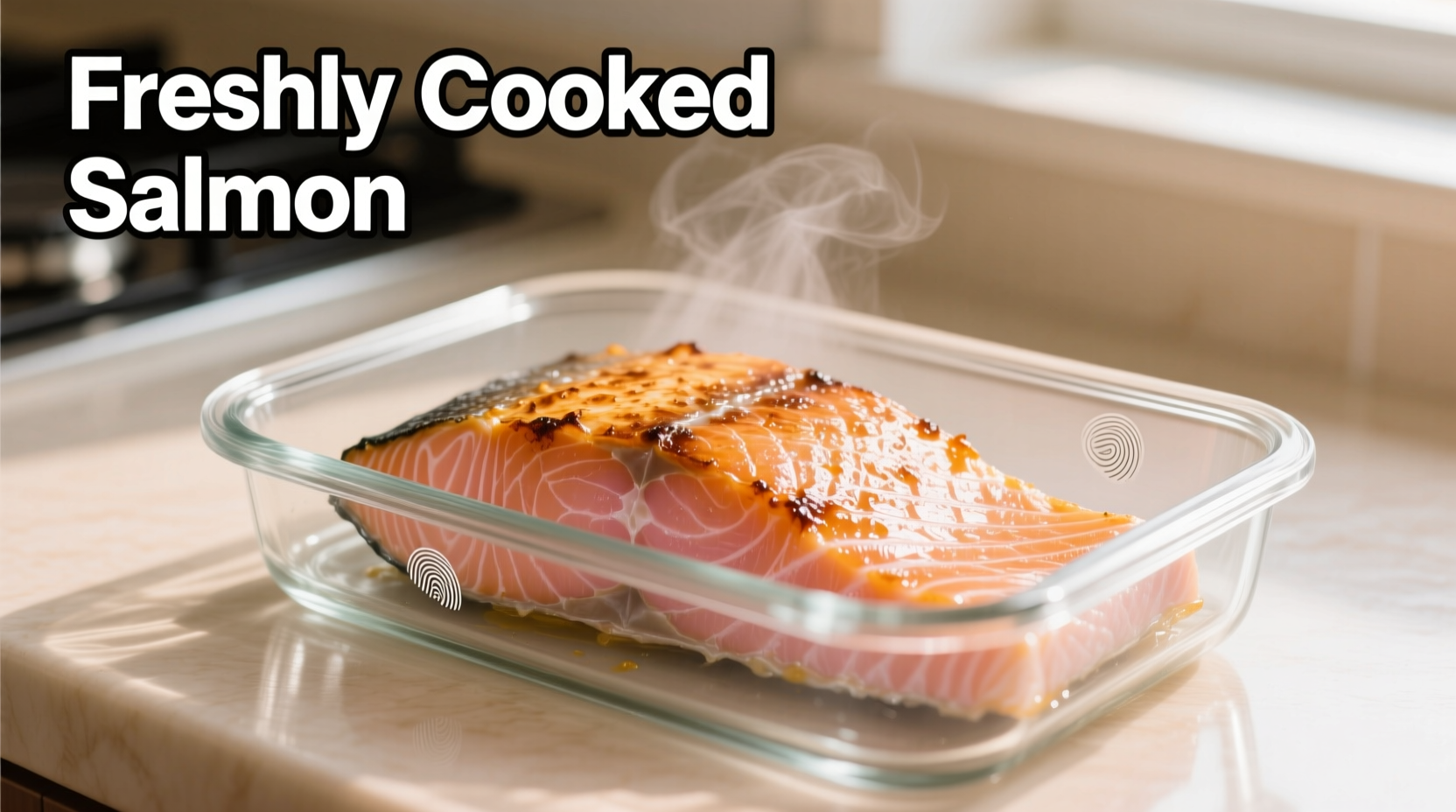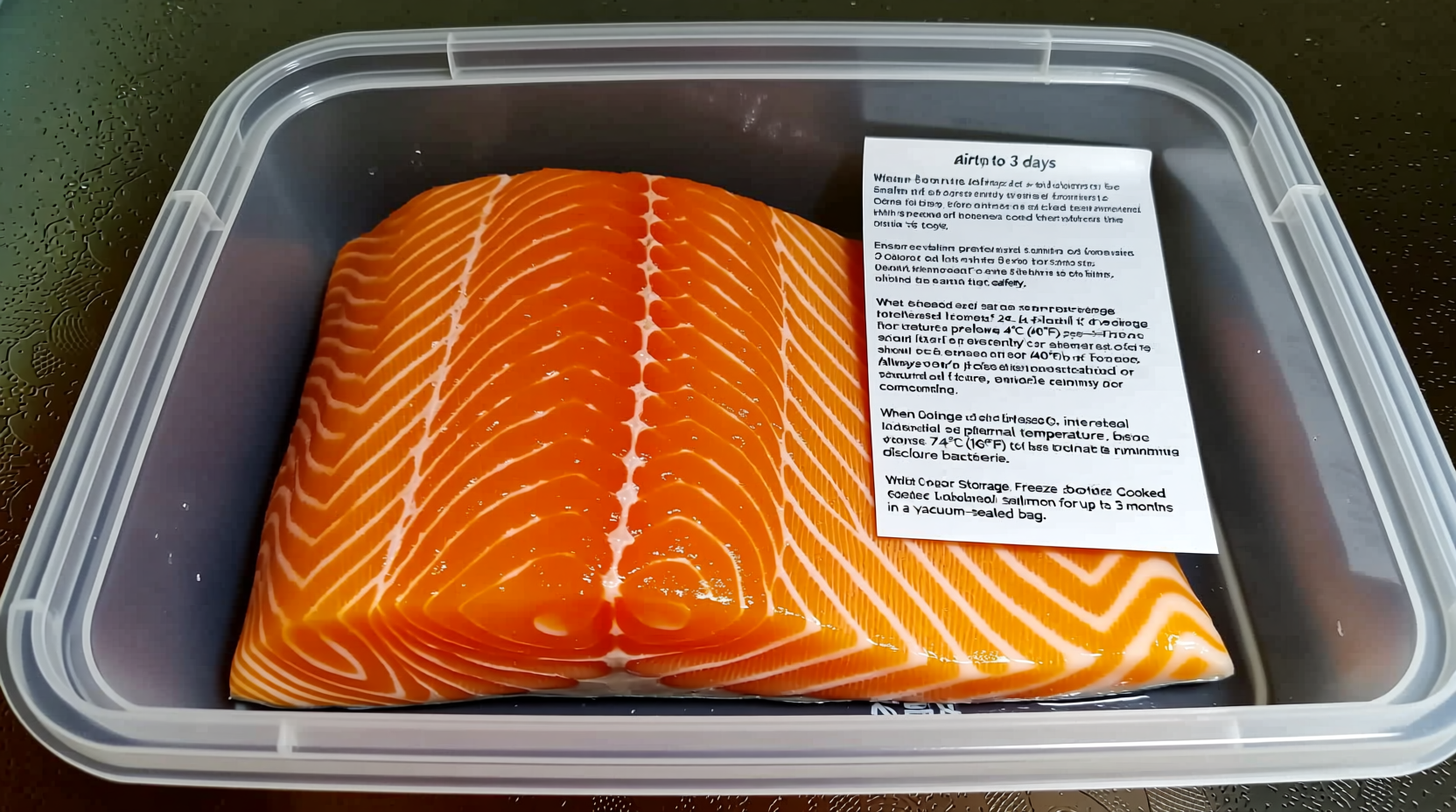Cooked salmon stays safe to eat for 3-4 days when properly stored in the refrigerator at 40°F (4°C) or below. This timeframe aligns with USDA Food Safety and Inspection Service guidelines for cooked fish storage. Always store salmon in airtight containers within 2 hours of cooking to maximize freshness and prevent foodborne illness.
Wondering if that leftover salmon from last night's dinner is still safe for lunch today? You're not alone. Millions of home cooks face this exact question weekly, trying to balance food safety with reducing waste. Getting this right matters—improperly stored fish causes thousands of foodborne illness cases annually. Let's cut through the confusion with science-backed storage guidelines you can trust.
Why the 3-4 Day Rule Matters for Cooked Salmon
Unlike raw fish, cooked salmon has reduced natural defenses against bacteria. The cooking process eliminates surface bacteria but creates an ideal environment for pathogens like Listeria and Salmonella to grow during cooling and storage. According to the USDA Food Safety and Inspection Service, cooked fish enters the "danger zone" (40°F-140°F) where bacteria multiply rapidly.
Temperature control is critical. A CDC temperature safety chart shows that bacteria can double in number every 20 minutes between 70°F-125°F. This explains why the "2-hour rule" (refrigerating within 2 hours of cooking) is non-negotiable for food safety.

Maximizing Freshness: Your Step-by-Step Storage Guide
Follow these professional kitchen techniques to extend your salmon's shelf life while maintaining quality:
- Cool rapidly: Divide large portions into smaller containers to cool faster (reduces time in danger zone)
- Airtight is essential: Use glass containers with tight seals or vacuum-sealed bags (plastic containers can absorb odors)
- Temperature check: Verify your refrigerator maintains 37-40°F using a standalone thermometer
- Top shelf placement: Store in the coldest part of the fridge (usually top shelves near the back)
- Moisture control: Place a paper towel under salmon to absorb excess liquid
| Storage Method | Maximum Safe Duration | Quality Indicator |
|---|---|---|
| Refrigerator (40°F or below) | 3-4 days | Firm texture, mild ocean scent |
| Freezer (0°F) | 2-3 months | No freezer burn, consistent color |
| Room temperature | 2 hours max | Discard immediately if left out longer |
Spotting Spoilage: Beyond the Calendar
While the 3-4 day rule provides a safety baseline, always verify freshness using your senses. The FDA's Safe Food Handling guidelines identify these critical spoilage indicators:
- Smell test: Fresh salmon has a mild ocean scent; spoiled salmon emits sour, ammonia-like, or rancid odors
- Texture check: Surface should be firm, not slimy or sticky to the touch
- Visual inspection: Look for fading color (grayish tint) or visible mold growth
- Taste caution: Never taste questionable fish—pathogens aren't always detectable by taste
Remember: When in doubt, throw it out. The USDA emphasizes that "no amount of cooking can eliminate toxins produced by certain bacteria once they've multiplied to dangerous levels."
Freezing Leftover Salmon: Your Long-Term Solution
Need to extend your salmon's shelf life beyond 4 days? Freezing properly can maintain quality for 2-3 months. Follow these steps for best results:
- Wrap tightly in moisture-proof material (freezer paper or heavy-duty aluminum foil)
- Vacuum-sealing removes oxygen that causes freezer burn
- Label with date using waterproof marker
- Thaw overnight in refrigerator—never at room temperature
- Consume within 2-3 days after thawing
Research from the National Center for Home Food Preservation shows properly frozen salmon maintains nutritional value and texture significantly better than refrigerated leftovers stored beyond 4 days.
Common Storage Mistakes That Shorten Shelf Life
Even with proper timing, these errors compromise safety and quality:
- Using takeout containers: Many aren't airtight—transfer to proper storage within 30 minutes
- Stacking warm containers: Creates heat pockets that accelerate spoilage
- Storing near strong odors: Fish readily absorbs refrigerator smells
- Reheating multiple times: Each cycle through the danger zone increases risk
Professional kitchens follow the "one-time reheat" rule: Divide leftovers into single-serving portions before refrigerating to avoid repeated temperature fluctuations.
Food Safety Timeline: From Cooking to Consumption
Understanding this progression helps prevent common mistakes:
- 0-2 hours post-cooking: Critical cooling window—must reach 40°F or below
- Days 1-2: Peak freshness and flavor retention
- Day 3: Quality begins declining; increased vigilance for spoilage signs
- Day 4: Final safe consumption day—discard after 120 hours regardless of appearance
- Day 5+: High risk period—USDA recommends immediate disposal
This timeline reflects data from the USDA Leftovers and Food Safety guidelines, which note that "the 4-day maximum applies even if the food still looks and smells good."
Special Considerations for Different Salmon Types
While the 3-4 day rule applies generally, these factors affect specific preparations:
- Smoked salmon: Lasts 5-7 days due to preservation process
- Marinated salmon: Acidic ingredients may extend shelf life slightly (still max 4 days)
- Casserole dishes: Mixed ingredients follow the shortest shelf life guideline (usually 3-4 days)
- Restaurant leftovers: May have unknown storage history—consume within 2 days
The University of Minnesota Extension notes that "fatty fish like salmon spoil faster than lean fish due to higher oil content, which oxidizes more quickly."
Reheating Leftover Salmon Safely
Proper reheating destroys surface bacteria but doesn't eliminate toxins from prolonged storage:
- Microwave: Cover with damp paper towel to prevent drying
- Oven: 275°F until internal temperature reaches 145°F
- Stovetop: Gentle warming in covered skillet with splash of liquid
Always use a food thermometer to verify internal temperature—visual cues alone aren't reliable. The FDA Food Code specifies 145°F as the minimum safe temperature for fish.
Your Food Safety Checklist
Before consuming leftover salmon, complete this quick verification:
- ✓ Stored within 2 hours of cooking
- ✓ Kept at consistent 40°F or below
- ✓ Within 3-4 day timeframe
- ✓ No sour or ammonia-like odor
- ✓ Firm texture without slime
- ✓ Consistent color without gray patches
Missing any of these criteria means it's time to discard the salmon. Your health isn't worth the risk of foodborne illness.











 浙公网安备
33010002000092号
浙公网安备
33010002000092号 浙B2-20120091-4
浙B2-20120091-4